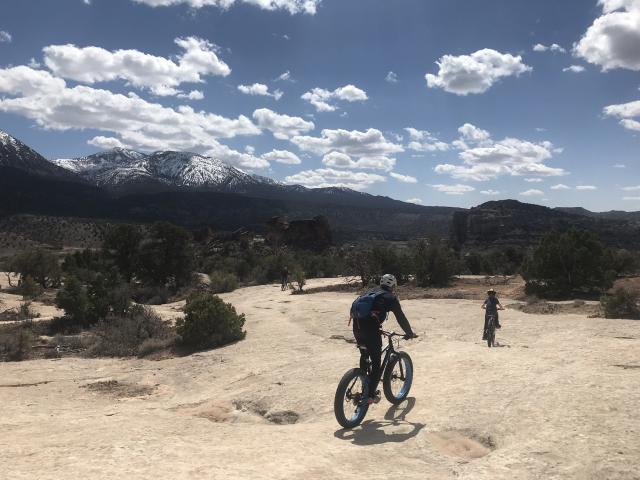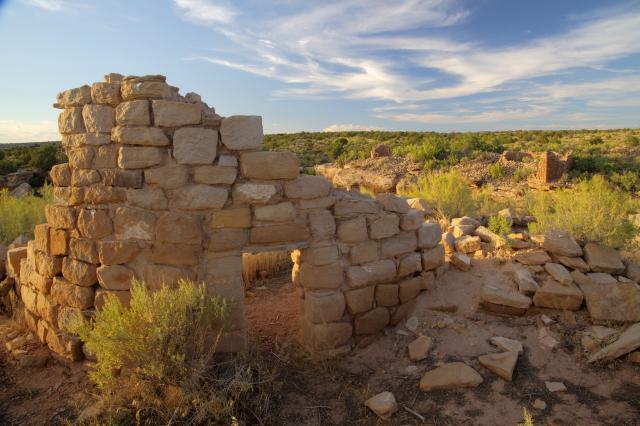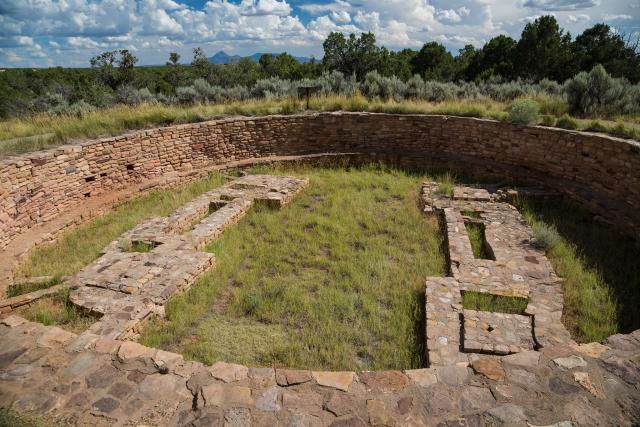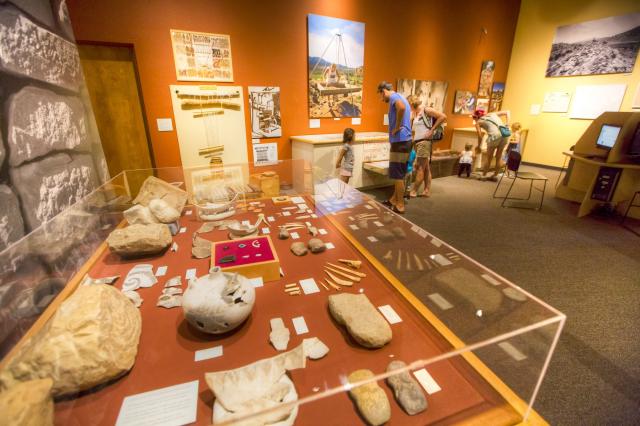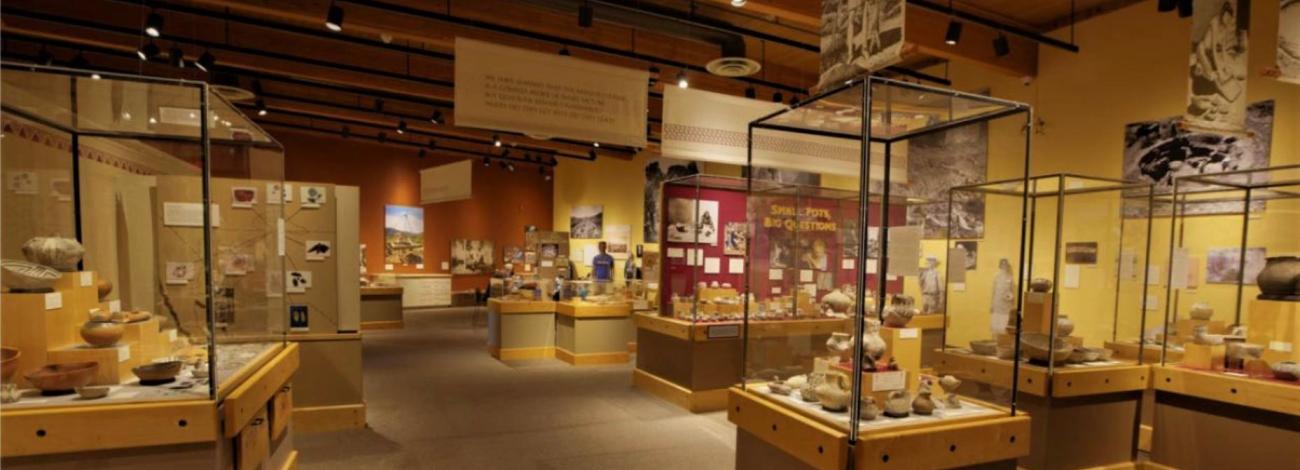
Visitor Center & Museum
The Canyons of the Ancients Visitor Center and Museum is the premier archaeological museum in Southwest Colorado and serves as the headquarters for Canyons of the Ancients National Monument. Located in Dolores at the foot of the San Juan Mountains and just 17 miles from Mesa Verde National Park, the museum offers an immersive introduction to the rich cultural heritage of the Four Corners region.
Through engaging exhibits and hands-on displays, visitors can explore the lifeways of the Ancestral Puebloans, learn how archaeologists uncover the past, and gain insight into the region’s more recent history. Permanent exhibits feature real artifacts, a replica pithouse, interactive learning stations, and two informative short films that highlight Native American perspectives and archaeological practices. Whether you’re beginning your Monument adventure or diving deep into the archaeology of the Four Corners, the Visitor Center is an essential first stop.
- Hours and Admission
Facility Hours
- Summer (March 1 through October 31): 9 am – 5 pm Tuesday through Saturday
- Winter (November 1 through February 28): 10 am – 4 pm Wednesday through Saturday
Admission Fees
- Visitor Center: Adults $7, under age 16 free. We honor and issue all America the Beautiful National Parks and Federal Recreational Lands passes (senior, annual, military, access, volunteer and 4th grade).
- Monument access and visitor information and services: Free
Holiday Closures: Thanksgiving Day, Christmas Day and New Year’s Day
Commercial Tour Groups: Tour groups (and any organized group over 15) visiting the National Monument are required to obtain a special recreation permit. Please call 970-82-5635 to learn more about CANMs permitting process. We encourage all groups over 15, organized and/or commercial to plan your visit to Canyons of the Ancients Visitor Center and Museum instead of the National Monument to help protect and preserve sensitive cultural resources. Call the front desk at 970-882-5600 to schedule your visit one month in advance.
School Groups: If you are interested in scheduling a field trip or have questions about our educational program offerings, please visit our For Educators page to learn more.
- Address
27501 Highway 184, Dolores, CO 81323
RV and bus parking is available.
- Features and Services
Canyons of the Ancients Visitor Center and Museum features interactive galleries and authentic cultural objects on display from the 3 million artifacts and records curated in the facility. It also hosts a small gift shop and rotating special exhibits. The Center’s knowledgeable staff are always available to help you have a positive experience. The facility is fully wheelchair accessible.
The Visitor Center grounds overlook McPhee Reservoir and feature two on-site archaeological sites: Dominguez Pueblo, a 12th-century structure once home to a small family, and Escalante Pueblo, accessible via a paved, half-mile trail with panoramic views and interpretive signage. Additional amenities include an outdoor picnic area and native plant gardens.
Ranger-guided programs, special events, and cultural demonstrations may be available during your visit; check the Activities and Events page in advance and look for posted signs when you arrive for same-day events. Self-guided activities can be picked up at the Visitor Center and Museum anytime, including a Junior Ranger booklet, museum scavenger hunts, and online at Agents of Discovery Missions.
The cultural objects curated by the museum, most of which were collected during the Dolores Archaeological Program, represent an invaluable resource for descendent tribal members, archaeologists, historians, graduate students, and other scholars and researchers. Anyone with a legitimate research interest may access the collection by prior arrangement with the curation department by calling 970-882-5622. Public tours of curation are not available at this time.
Special Events
See the Activities and Events page for special events including annual events, Four Corners Lecture Series, Cultural Demonstrations, Service Projects, and more!
School Groups
See the For Educators page for information about bringing students on a field trip to Canyons of the Ancients Visitor Center & Museum and classroom visits. Resources for educators, including self-guided field trips and lesson plans, are also available.
- Get Involved
Partners: Canyons of the Ancients Visitor Center and Museum is operated by the Bureau of Land Management with assistance from Southwest Colorado Canyons Alliance and San Juan Mountains Association.
Southwest Colorado Canyons Alliance (SCCA) is the official friends group to Canyons of the Ancients National Monument. They help provide the special programming and events year-round. Visit their website to learn how you can get involved: https://swcocanyons.org/.
San Juan Mountains Association (SJMA) provides Visitor Center staff and skilled educators who help deliver educational programming at Canyons of the Ancients Visitor Center and Museum. Visit https://sjma.org/ to learn more. Email [email protected] to schedule a field trip today!
Volunteers: We welcome volunteers to help further the mission of the monument and the BLM. For more information, call 970-822-5600.
Internships: Student internships are periodically available in Curation and Visitor Services. For more information on what internships may be available, call 970-822-5600.
Artist in Residence: Canyons of the Ancients hosts two Artists in Residences each year. Visit our Artist-in-Residence page to learn about current opportunities and apply today at: https://swcocanyons.org/artist-in-residence-program/.
- Contact Us
Visitor Center and Museum: 970-882-5600

